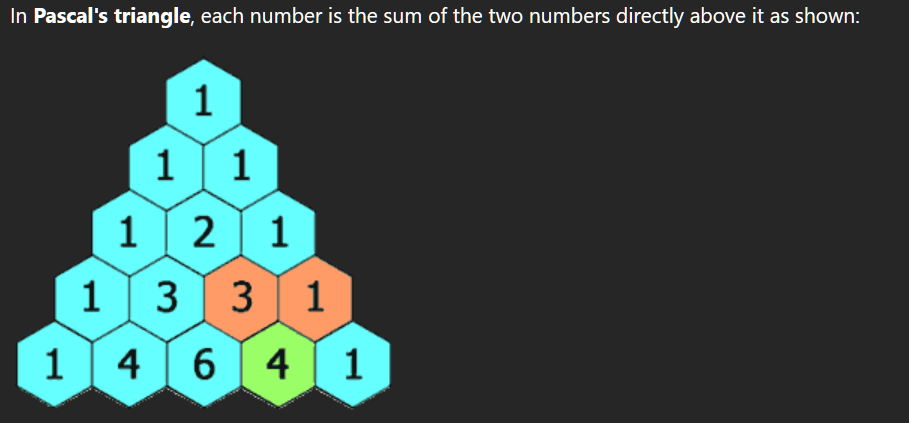Pascal's Triangle
 Yash Mehta
Yash MehtaTable of contents

Pascal's Triangle - LeetCode
Intuition
The code generates Pascal's Triangle up to the specified number of rows (numRows). Each row is constructed based on the elements of the previous row, with the first and last elements always being 1.
Approach
Initialize a list of lists (
ans) to store the generated triangle.Generate the first two rows separately and add them to the result.
Use a nested loop to generate subsequent rows based on the sum of two elements from the previous row.
Add each row to the result (
ans).
Complexity
Time complexity: O(*numRows^*2), where
numRowsis the number of rows in the generated triangle. The nested loops iterate over each element in each row, and the number of rows is proportional to the square ofnumRows.Space complexity: O(*numRows^*2), as the space required for storing the triangle is proportional to the square of
numRows.
class Solution {
public List<List<Integer>> generate(int numRows) {
// Initialize variables
int counter = 0;
List<List<Integer>> ans = new ArrayList<>();
// Generate the first row
List<Integer> innerList1 = new ArrayList<>();
innerList1.add(1);
ans.add(innerList1);
// Check for special case: numRows <= 1
if (numRows <= 1) {
return ans;
}
// Generate the second row
List<Integer> innerList2 = new ArrayList<>();
innerList2.add(1);
innerList2.add(1);
ans.add(innerList2);
// Generate subsequent rows
for (int i = 3; i <= numRows; i++) {
List<Integer> innerList3 = new ArrayList<>();
// Populate the current row based on the previous row
for (int j = 0; j < i; j++) {
if (j == 0) {
innerList3.add(1);
} else if (j == i - 1) {
innerList3.add(1);
} else {
// Calculate the current element based on the sum of two elements in the previous row
int num2 = ans.get(i - 2).get(j - 1);
int num1 = ans.get(i - 2).get(j);
innerList3.add((num1 + num2));
}
}
// Add the current row to the result
ans.add(innerList3);
}
// Return the final result
return ans;
}
}
Subscribe to my newsletter
Read articles from Yash Mehta directly inside your inbox. Subscribe to the newsletter, and don't miss out.
Written by
